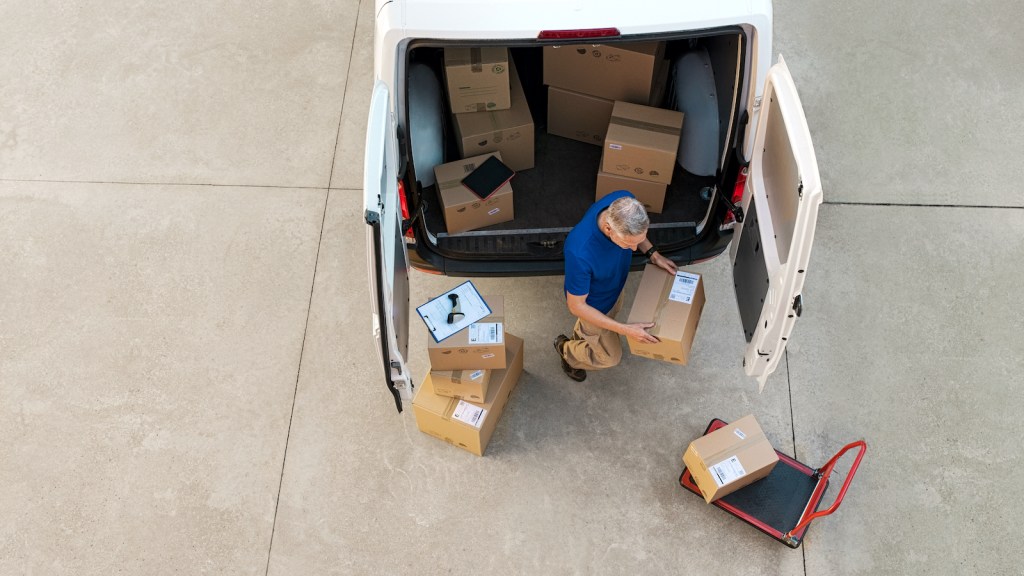Table of Contents
** Minutes
Why is delivery management important?
Key challenges in delivery management
How to measure the efficiency of your delivery management system
5 benefits of a strong delivery management system
10 ways to improve the delivery management processes
Top 6 delivery management software solutions
A note on delivery management trends in 2023
ShipBob knows best: trust the experts when it comes to delivery management
Fast, reliable, and consistent delivery drives memorable post-purchase experiences.
But as an ecommerce operator (and not a carrier), you might be thinking: do I have much control over delivery operations?
The answer is yes. In today’s fast-growing industry, there are endless ways to improve the delivery process, especially with the right systems in place.
In this article, learn why delivery management is important for business growth, and how you can improve your delivery strategy to meet customer expectations.
What is delivery management?
Delivery management is the process of overseeing the transportation of finished goods from one location to the next.
For ecommerce businesses, it means optimizing last-mile delivery for shipping customer orders to make sure that they arrive on time and undamaged. Since online shoppers expect a perfect delivery experience every time they order, proper delivery management is absolutely critical to retaining customers and maintaining profit margins.
Why is delivery management important?
With ever-increasing customer expectations, on-demand logistics solutions are becoming an essential component of the supply chain.
Online retailers are feeling the pressure of delivering customer orders quickly to boost brand loyalty and stay competitive.
Delivery management starts with a strong fulfillment and logistics strategy. The fulfillment experience involves picking and packing items and shipping orders through the most optimized route in terms of speed and cost.
But without the proper fulfillment infrastructure and supply chain technology in place, the ability to deliver orders quickly and accurately can be a challenge.
Key challenges in delivery management
Getting customer orders on doorsteps intact and on time is a lot more complicated than the average consumer might realize. In fact, ecommerce brands face many challenges when managing their deliveries.
Inventory management issues
To fulfill and deliver orders, inventory needs to be in the right place at the right time. If a brand is struggling with stockouts or can’t balance inventory levels across their fulfillment network to meet demand, they won’t have the products on hand to fulfill an order when it comes in. This creates backorders and delays in getting orders to customers.
Proper replenishment timing, real-time inventory tracking software, and thorough demand forecasting can help a brand avoid inventory management issues and facilitate timely delivery.
Increased demand for fast and efficient delivery
Like it or not, 2-day delivery has become the new standard for ecommerce. According to a recent report, 90% of consumers now consider delivery within 2-3 days tablestakes, with 30% expecting same-day delivery options when shopping online.
This expectation can put smaller brands in a bind. While express shipping is expensive and can eat away at a merchant’s profit margins, merchants may not have the capital to run the network of multiple, strategically-located warehouses needed to distribute inventory and minimize shipping costs and times.
For this reason, many smaller ecommerce businesses choose to partner with a logistics platform like ShipBob. Top-notch fulfillment and shipping partners can help your brand distribute inventory near customer hubs for quicker, cheaper shipping without the hefty price tag.
Growing competitive pressure
Ecommerce giants like Amazon are increasingly turning delivery into a competitive differentiator. Whether it’s offering free 2-day shipping on all online orders a wide variety of delivery options (same-day, next-day, or even BOPIS), large retailers and ecommerce platforms have the logistics network and resources to deliver on customer expectations on a massive scale.
Granted, DTC brands may be able to provide bespoke touches in delivery that bigger competitors cannot, such as a custom unboxing experience or personalized notes or inserts. DTC brands can even leverage a retailer partner’s dropshipping or retail distribution programs to reach new customers. But as competition grows steeper, smaller brands must be creative to keep pace with larger players’ delivery strategies.
Rise of cross-border ecommerce (and its complications)
Ecommerce is a global industry, and brands are no longer limited to selling to local customers. Now, merchants have the option of launching their brand in international markets, and reaching millions of new customers and demographics.
But with new opportunities come new complications. The desire for fast, affordable shipping is universal, but international delivery often comes with long wait times and high shipping price tags. In addition, the geopolitical landscape is constantly changing, and these changes and challenges often affect international shipping and delivery.
By building a resilient and agile supply chain, merchants can navigate the global ecommerce market with grace – and by establishing fulfillment and shipping operations locally within a country to which you ship, your brand can avoid many cross-border complexities, duties, tariffs, and taxes.
Customer expectations and complaints
According to one study conducted in 2022, 85% of online shoppers report that a single negative delivery experience with a brand would prevent them from purchasing from that brand again in the future.
While some customers may be able to forgive a brand for the occasional mishap, if your delivery management strategy consistently results in lost, damaged, or undelivered orders, customers aren’t likely to stick around long. Worse yet, they could leave you negative reviews online, and discourage other consumers from making purchases.
How to measure the efficiency of your delivery management system
Now that we know why a delivery management system is important, especially with the rise of customer expectations, we invite you to take a look at your delivery management system to see how efficient it actually is.
Monitor delayed deliveries
How often are there delays in your delivery system? Delivery exceptions occur in an entropic world from time to time due to inclement weather or road construction. But identifying what caused them is an important aspect of delivery management. If delivery delays occur far too frequently and for things within your control, it might be time to take a step back and consider your options.
Documenting your delayed deliveries can help you identify a pattern if there is one. Or, a list of the most common causes, which is the first step to solving those problems, especially if they occur regularly and are within your control.
Know your average time per delivery
Your average time per delivery can depend on many factors, specifically the location of your clients. If you consistently ship locally and your clients enjoy free two-day shipping, that’s one thing, but if you ship across the country or even ship internationally, you should pay closer attention to your average time per delivery. This is not only so your customers know what to expect, but so you can problem-solve if there is a delay and work on reducing shipping time.
Calculating your average time per delivery is easy; simply add the total days it took for separate items to be delivered, and divide that by the number of deliveries. If you have thousands of deliveries you can consider taking a random sample of ten or 100, or some other manageable number to add up. Some use workweek days, but with some shipping carriers operating seven days a week, you can include those as delivery days.
This process is significantly easier if you partner with an ecommerce enablement platform like ShipBob that tracks key delivery metrics for you. Through ShipBob’s analytics dashboard, merchants can see what percentage of their orders arrived in certain delivery windows, as well as average transit time for different shipping methods.
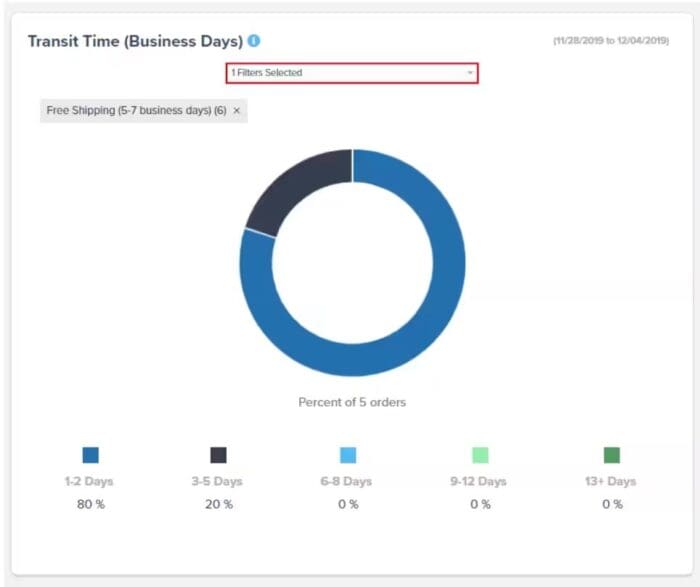
Track your average cost of delivery
It goes without saying that free two-day shipping has spoiled us all, and competing with that as a business can be very difficult. That is why knowing your delivery speed and costs are important to remain competitive.
Similar to your average time per delivery, you’ll want to add up how much each delivery costs, and divide that by the number of deliveries.
Say you have 10 deliveries this week, all with varying costs. Add all of those costs together to get the total, then divide that by ten (the number of deliveries). This will result in the average cost of your deliveries for that time frame. With this information in hand, you can analyze what you spend and work to reduce that cost without sacrificing time in transit, of course.
You can also go deeper into average delivery cost data to isolate different insights. For instance, ShipBob’s dashboard will show you your brand’s average shipping cost by state and by shipping method, and even track average fulfillment costs (which you may or may not include in total delivery cost).
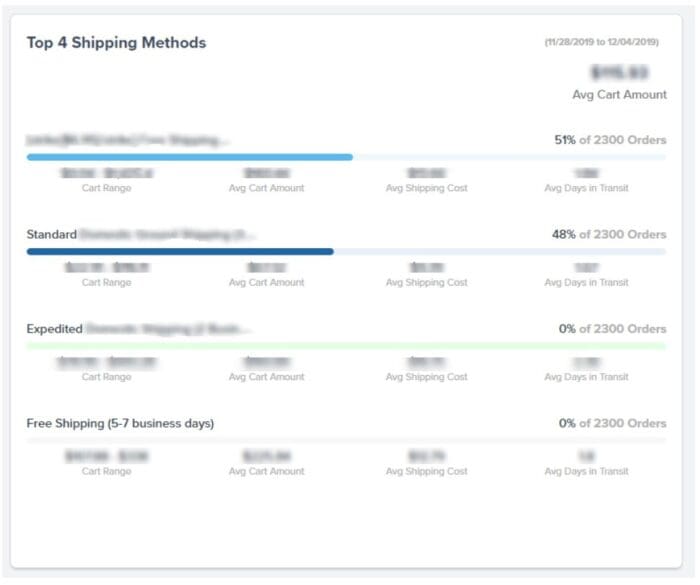
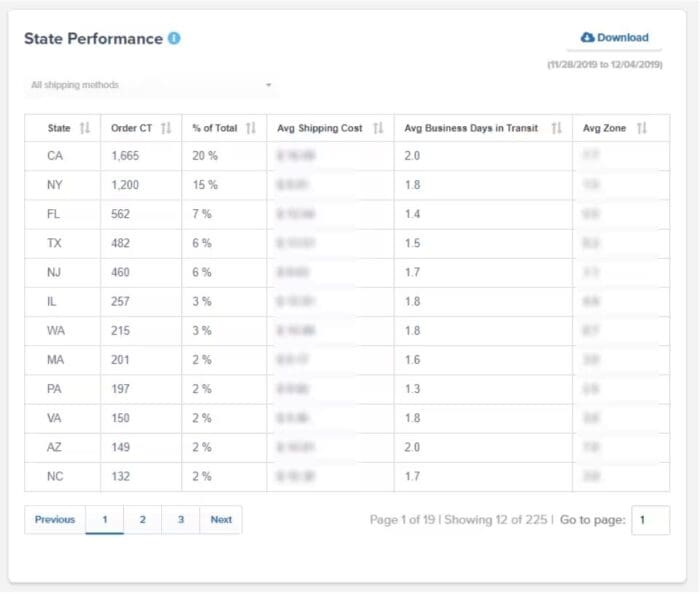
Keep track of your customer satisfaction score
Feedback can be one of the most resourceful roller coasters for business owners. Sometimes feedback can breathe life into your business, and sometimes criticism can be a major blow to your enthusiasm and profits. However, knowing what people have to say, both good and bad, can help set you up for success. When someone leaves sub-optimal feedback, you can easily address not only this person’s complaint directly, but you can address the root of the problem before it happens again.
5 benefits of a strong delivery management system
How consistent you are in delivery highly impacts both the customer experience and your bottom line.
Without a proper delivery management system in place, you can’t offer the variety of shipping methods that customers expect, which can increase your cart abandonment rate.
Post-purchase, if your delivery system lacks visibility and reliability, it can lead to higher shipping costs and slower transit times (and customers who are less likely to buy from you again).
By investing in your delivery process, you can improve both sales and internal operations. Here are the top benefits of implementing a strong delivery management system.
Higher customer retention rate
Once a customer makes a purchase, the customer experience doesn’t stop there. The shipping experience is key to establishing a proper delivery strategy.
The right delivery management system can help minimize shipping costs, shipping times, and customer complaints. For example, healthcare brand Baby Doppler used to struggle to meet customers’ expectations for 2-day shipping – but after partnering with ShipBob, they were able to optimize their delivery strategy to achieve a nearly perfect 5/5 rating from customers.
“We used to have a lot more complaints with 2-day shipping before partnering with ShipBob, but with our inventory strategically distributed, we can cut lead times and really follow through on the 2-day promise.
It also helps that ShipBob isn’t locked to a specific carrier for 2-day service, and instead partners with a bunch of different carriers to find the best rate and most optimal route. I think that’s very beneficial, because if one carrier has a problem, ShipBob can use a different one to get our orders to customers on time. Overall, our customers seem much happier since we switched to ShipBob, and we’re not getting negative reviews on our 2-day shipping anymore.”
Mithu Kuna, Founder and CEO of Baby Doppler
Access to real-time data
Real-time order tracking provides more visibility into the shipping process, so you can automatically share updates with your customers on when their orders will arrive.
Many delivery management systems also provide access to shipping and delivery insights, so you can track shipping history, view estimated delivery dates, and even compare shipping methods based on customer preferences and delivery performance.
With the right data at your fingertips, you have what you need to make informed decisions and make improvements to your shipping strategy. Coffee creamer brand Prymal, for instance, leverages the shipping data on ShipBob’s merchant dashboard to help her budget costs and manage her own warehouse operations.
“The merchant dashboard is still really helpful for support inquiries (if an order needs to be canceled, if we need to adjust an address, add a product, etc.), as ShipBob is our source of truth for shipping data.
I also love the analytics tools, and so do my accountants. I can also see how my team is doing, tracking their order metrics as they fulfill orders. While we now pay for our own rent and the salaries of our fulfillment center team, we have been able to save 10% and reinvest that into other parts of the business.”
Courtney Lee, Founder of Prymal
Reduced operational costs
Delivery management aims to reduce shipping costs, so you can improve profit margins.
There are many factors that influence shipping costs. Keeping an eye on different carrier options is important, as well as avoiding common packing mistakes that increase costs, like using too large of packaging (for a higher dimensional weight).
Depending on the areas you ship to, different carriers (including regional parcel carriers) may also offer cheaper rates than what you’re currently paying. Having a logsitics professional like ShipBob as a partner can help you find compare rates and find the best deals and save money. ShipBob merchant Spikeball, for example, saved an estimated $400,000 on postage by leveraging ShipBob’s WMS and expertise.
“We were hesitant about leveraging ShipBob’s transportation management system at first – but it’s actually been really great.
Before we were manually choosing rates for orders coming out of our warehouse, but now ShipBob’s WMS automatically selects the best delivery method for us so it costs us less and our customers get faster shipping.
We’re saving hundreds of thousands of dollars per year, just in postage. When we first got started, we estimated over $400,000 in savings.”
Adam LaGesse, Global Warehousing Director at Spikeball
Faster delivery options for customers
With an efficient delivery management process, you can offer your customers faster delivery options.
There are a lot of factors that play into fast delivery, such as where you store inventory and fulfill orders geographically. The closer inventory is to your customers, the sooner packages can arrive at their doorstep at a more affordable rate.
For instance, ShipBob is a ecommerce enablement platform that operates multiple fulfillment center locations. By allocating inventory across locations, orders can be sent to the closest fulfillment center to its destination to be picked, packed, and shipped right away (without the need for a brand to manage one, let alone multiple warehouses themselves).
ShipBob even offers an ideal Inventory Distribution Tool to help you calculate the most strategic product allocation split across ShipBob’s fulfillment center network, so you can offer 2-day shipping to more (or all!) of your customers without breaking the bank.
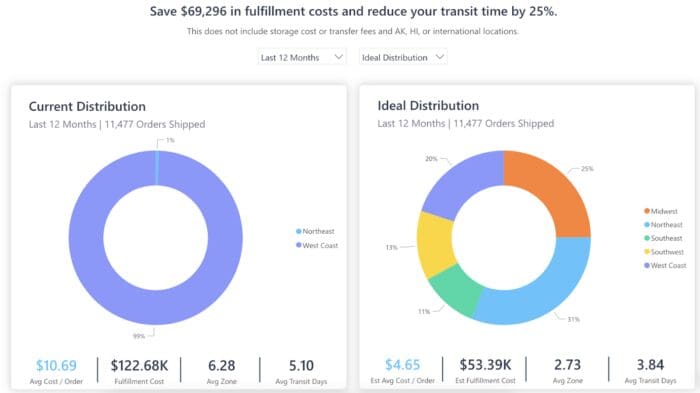
Increased supply chain communication
There’s a lot of data that needs to be shared throughout the supply chain, and it must be recorded, analyzed, and shared with the proper parties in a timely manner.
Delivery management systems can help increase supply chain communication between third-parties that are involved in the shipping and delivery process.
By connecting inbound and outbound logistics with the right technology, you’re able to optimize the supply chain and ensure orders are shipped and delivered efficiently.
10 ways to improve the delivery management processes
To meet customer expectations around fast, accurate delivery, here are 10 ways you can improve the delivery management process.
1. Pick the right delivery management system
Picking the right delivery management system or app that easily integrates with your other systems is the first step in improving the delivery process.
Since every business runs its logistics operations differently, it’s important to take the time to choose the right technology for your business. But some of the key features to look for include:
- Real-time order tracking
- Advanced data and analytics
- Route optimization
Another important feature to consider is direct integrations, especially if you partner with a 3PL. By connecting a delivery management system with a 3PL’s software (or using the 3PL’s built-in tools), you can further streamline the shipping process.
2. Optimize your inventory management system
Inventory management plays an essential role in the delivery process. Without the right items to fulfill an order, delivery is already delayed before it’s even shipped.
Inventory management software provides real-time insights into inventory levels, the ability to create and manage SKUs, identify which items are fast selling or slow-moving, and more.
For instance, ShipBob’s technology has built-in inventory management technology that makes it easy to replenish inventory by setting reorder notifications, bundle products for promotions, and even make inventory transfer requests.
“I like to look at the analytics in the ShipBob dashboard, knowing exactly what I have for storage. I can also set up alerts to know when I’m low on inventory for certain products to make replenishment easier. The bundling process is really good. Before ShipBob we would do it with an Excel table, which was a lot to manage.”
3. Automate shipping
Automated shipping technology and processes allow for much faster delivery. But many time-consuming tasks like packing, adhering shipping labels to boxes, and controlling stock can now be automated, so you can reduce manual work and improve accuracy.
Having a streamlined shipping process enables you to increase production, allowing you to cater to a larger volume of orders in less time.
As a result, this leads to more growth and optimization throughout the supply chain. To automate shipping, many brands partner with a 3PL like ShipBob that has systems and processes in place to automate fulfillment and delivery.
That way, you don’t have to worry about shipping orders, invest in costly automation, or spend time finding ways to optimize the delivery process.
“Since partnering with ShipBob, we now have an automated system for shipping and can focus our time on new product launches. We continually are able to reliably and quickly fulfill thousands of orders during a single apparel drop. This partly has to do with ShipBob saving us time by automating the order fulfillment process.”
Jason Ton, CFO of 100 Thieves
4. Easily generate shipping labels
An important part of the delivery process is generating shipping labels, but it can be an extremely time-consuming process. And if done manually, any small error can cause delivery delays during already small delivery windows (or reshipments).
Fortunately, there are ways to easily generate shipping labels at a much faster rate.
If you manage a high volume of orders, outsourcing fulfillment to a 3PL like ShipBob that purchases and generates shipping labels for you can take the hassle and stress out of label creation.
ShipBob will make sure your customers’ orders are labeled and shipped properly, taking care of the entire shipping and handling process.
5. Use distributed fulfillment centers
The best way to reach customers more efficiently and offer faster (cheaper) delivery is to utilize more than one fulfillment center location. Fulfilling orders from more than one warehouse allows you to speed up delivery times at an affordable rate via ground shipping.
The quicker a customer gets their order, often the happier they are. If you can offer a quick turnaround time – without the need for costly expedited shipping, you can meet customer expectations while keeping logistics costs low.
“The network and team that ShipBob has are incredible. We’re able to leverage a vast network of domestic fulfillment centers. The ability to touch base with the team and use a data-driven approach for identifying areas of improvement and where we might benefit from expanding our use of the ShipBob fulfillment center locations has saved us time and allowed us to provide better experiences for our customers.”
Stephanie Lee, COO at PetLab
6. Keep your customers in the loop
Customers like to know right away if their order is being processed. It provides peace of mind, knowing that their order has been acknowledged and is promptly prioritized.
Providing frequent order updates keeps your customers in the loop, making them aware of the progress at each stage, from order processing all the way through delivery. Not only do customers appreciate the updates, but you can save your ecommerce customer service team time by reducing the amount of customer inquiries.
The more transparency you can provide customers, the better. Depending on the type of systems you have in place, you can choose to send customers updates on when an order is received, processed, being prepared, and shipped.
7. Set up a return management process
It’s important to create a return management process that is easy to understand for your customers and also for your team to execute. Customers may even be more likely to make an exchange, knowing they can get the new item delivered quickly.
Additionally, an easy return process can help your team sort, organize, and restock returned inventory.
A 3PL like ShipBob can help support the ecommerce returns process. With ShipBob, you have the option to restock, quarantine, or dispose of returned products at the SKU level (or even sent back to you directly). On your end, all you have to do is choose how you want each individual product to be processed, and our team can handle the rest.
“About a year and a half after building out our business, we figured it was time to optimize some of our processes, including returns. The ability to work with one of the co-founders of ShipBob to launch a new, custom returns process was awesome.
Returns were taking a lot of time and resources to process on our end, but ShipBob was super helpful and critical in creating a solution for us.”
Nikolai Paloni, Co-Founder of Ombraz Sunglasses
8. Offer order tracking
Order tracking is essential to share with customers, allowing them to take control of deliveries, which ultimately improves the delivery experience.
Many carriers like how UPS offers programs like My Choice and Access Point to make sure deliveries fit into your customers’ schedules. These types of programs can reduce lost and stolen deliveries, which is ideal for high-value orders. It also makes it much more convenient for your customers (especially if they know about them!).
9. Optimize your route planning
Route optimization is a key part of delivery management. By having the right technology in place to identify the most efficient route, you can ship orders fast and at the most affordable rate.
Delivery management systems come with route optimization tools and also provide data and insights that help you make better decisions on shipping.
For instance, ShipBob’s technology allows for faster shipping times by being able to analyze optimal delivery routes and fulfilling orders from the most efficient location within our network.
10. Set the right expectations with customers
Setting expectations with your customers can go a long way in keeping them happy, and it can also protect your brand.
Make sure you always have a clear shipping policy published on your online store that’s easy to find, which should include estimated shipping datesand costs for different shipping methods, such as ground shipping, global shipping, and expedited shipping.
Internally, make sure your retail fulfillment team has training on how to handle and ship fragile items, HAZMAT shipments, and any other product-specific needs.
In the case of packages arriving damaged, make sure you have a process in place to respond to shipping damages, including how to file claims with carriers (ShipBob does this for free on behalf of our customers).
It’s also a good idea to have shipping insurance to cover orders that are lost, stolen, or arrive damaged.
Top 6 delivery management software solutions
To enhance the delivery process, there are several delivery management solutions on the market.
To help you source the right delivery management software for your ecommerce business, it’s important to look for a solution that has the ability to track in-transit orders in real time, utilizes machine learning, offers data and analytics, and provides route planning and optimization tools.
Note: If you partner with a tech-enabled 3PL like ShipBob, you may not need additional tools, but choosing a delivery management software that complements your 3PL’s technology can help you automate shipping and streamline the delivery process.
Below is a high-level overview of some of the most popular delivery management software options for ecommerce.
| Delivery Management Software | Top Features |
| Route | Real-time Visual Tracking™ Premium order protection |
| AfterShip | Real-time tracking data Branded tracking page |
| Elite EXTRA | Dispatch management Route optimization Real-time GPS tracking |
| Onfleet | Dispatches and delivery routes Track drivers and communicate with them in real time Real-time updates for customers |
| Routific | Real-time updates for customers Route optimization Notifications for when packages are delivered |
| Tookan | Route optimization Automatic dispatch Tracking analysis and reporting |
A note on delivery management trends in 2023
Delivery management is constantly evolving. New technologies and delivery strategies are giving ecommerce brands more ways to reach customers, and are giving customers more options for how they want to get deliveries.
This means that even if your brand has a delivery strategy that has worked well in the past, you should still stay up-to-date on the latest trends in delivery management. This will enable you to build a more resilient and agile delivery strategy that can not only withstand anticipated challenges (such as peak season order volumes), but also unexpected challenges.
Emerging trends in delivery management
Sustainable fulfillment and delivery
Eco-conscious consumers are no longer just a niche demographic. In fact, one recent study found that in 2023, 86.4% of consumers considered sustainability at least “somewhat important” when buying online.
Brands that want to be mindful of customers’ values should consider optimizing their delivery strategy to be as eco-friendly as possible. This could mean optimizing delivery routes and modes to minimize carbon emissions, packing orders differently to minimize wasted packaging materials, or even partnering with a sustainability-minded fulfillment partner like ShipBob.
The good news? This same report notes that the majority of consumers would pay at least 5% extra and wait at least one extra day for more sustainable delivery.
Personalization
Now that affordable 2-day delivery is tablestakes, ecommerce brands are finding new ways to set themselves apart from the competition.
One of the best ways to distinguish your brand in the mind of a customer is through personalization. Ecommerce businesses can curate memorable deliveries and unboxings by using branded packaging, gift notes, special marketing inserts, and more. With a fulfillment partner like ShipBob that supports these customization capabilities, it’s easy to implement across thousands of orders and delight shoppers with a unique delivery experience.
Phygital retail
Phygital retail merges online and offline platforms and tools to create an integrated and seamless shopping experience – which includes delivery. To provide a standout delivery experience, consider incorporating phygital elements into your delivery management strategy, such as:
- Mobile apps that enable customers to track their orders in real time
- QR codes that customers can scan for a map of their order in transit
- Smart lockers powered by the Internet of Things (IoT) where customers can securely pick up their orders
ShipBob knows best: trust the experts when it comes to delivery management
To improve the shipping and delivery process, you need the right systems, technology, and expertise.
Many online brands find success partnering with a ShipBob, a best in-class 3PL that can support your shipping and delivery needs.
With ShipBob’s domestic and global shipping capabilities, carrier partnerships, discounted shipping rates, and automated shipping solutions, you can worry less about optimizing your delivery process.
Our logistics automation software ensures accurate and fast fulfillment, as well as the ability to track and manage orders in real time.
For a more robust solution, ShipBob partners with leading delivery management systems including Route and AfterShip to provide more data, visibility, and transparency into the delivery process.
To easily get started with ShipBob, click the button below for more information.
Delivery management FAQs
Here are the top questions about delivery management
Why is delivery management important for ecommerce?
Delivery management is vital for ecommerce businesses as it helps retain customers and drive customer satisfaction. It involves optimizing the entire delivery process, starting at fulfillment to shipping. Delivery management ensures internal efficiency, so orders can be delivered quickly and accurately to satisfy customer expectations.
How does delivery management work?
Delivery management works by analyzing how companies can get goods from a fulfillment center to their final destination. This includes how quickly goods can be picked, packed, and shipped. In many cases, technology is used to ensure the right packaging is used, identify the most optimized route, and generate order tracking, so customers can stay in the loop on orders.
How can you improve your delivery management process?
The best way to improve the delivery management process is to implement technology and automation. With the right systems in place, you can improve visibility, track orders in real time, allow customers to track their deliveries, and optimize routes. Over time, you can track shipping insights and data to make informed decisions on how to improve the delivery process.
Can you outsource delivery management?
3PL companies like ShipBob operate multiple fulfillment locations powered by their leading technology. With ShipBob, you can automate the shipping process. ShipBob partners with multiple carriers and uses technology to identify the most efficient route. That way, orders are delivered quickly and at the most affordable rate.
